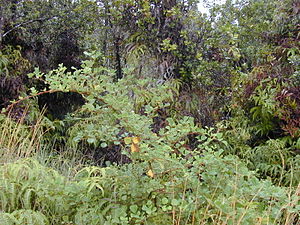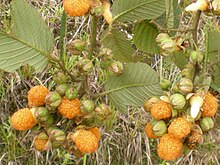Rubus ellipticus
| Rubus ellipticus | ||||||||||||
|---|---|---|---|---|---|---|---|---|---|---|---|---|

Rubus ellipticus |
||||||||||||
| Systematics | ||||||||||||
|
||||||||||||
| Scientific name | ||||||||||||
| Rubus ellipticus | ||||||||||||
| Sm. |
Rubus ellipticus called rare yellow Himalayan raspberry or Himalayan wild raspberry, is a plant of the genus Rubus in the family of the rose family (Rosaceae). It iswidespreadin southern Asia and a neophyte in many areas of the world. It can be used in many ways.
description

Appearance and leaf
Rubus ellipticus grows as an evergreen shrub that reaches heights of 1 to 3 meters. The bark of the branches is purple-brown or brownish and initially hairy. There are sparsely curved spines on the branches and they are densely covered with purple-brown bristles or glandular hairs.
The alternate leaves are arranged in a petiole and a leaf blade. The petiole is 2 to 6 inches long. The leaf blade is unpaired, pinnate in three parts. The two lateral leaflets are almost sessile and the terminal leaflet is stalked 2 to 3 centimeters long. The leaf rhachis and the pinnate leaf stem are covered with purple-red, tiny prickly hairs. With a length of 4 to 8, rarely up to 12 centimeters and a width of 3 to 6, rarely up to 9 centimeters, the spreading of the leaflets is elliptical or obovate with a rounded base and a pointed upper end, which is sharply pointed, somewhat heart-shaped or almost trimmed. The edge of the leaflets is unevenly tiny, sharply serrated. The underside of the pinnate leaves is densely tomentose and has purple-red bristle hairs along the raised leaf veins . On the upper side of the pinnate leaves only the central vein is hairy downy. The terminal leaflet is much larger than the lateral ones. The two downy and glandular hairy stipules are linear with a length of 7 to 11 millimeters.
Inflorescence and flower
The flowering period in China extends from March to April. The detached, densely clustered, racemose inflorescence is rarely 1.5 to usually 2 to 4 inches long and contains some up to ten or more flowers. In the leaf axils there are also one or usually a few flowers. The inflorescence axes and pedicels are hairy bristly. The fluffy hairy bracts are linear with a length of 5 to 9 millimeters. The flower stalk is 4 to 6 millimeters long.
The hermaphroditic flowers have a diameter of 1 to 1.5 centimeters and are radially symmetrical and five-fold with a double flower envelope . The five upright sepals are dense yellowish-gray tomentose and sparsely bristly hairy on the underside and with a length of 4 to 5, rarely up to 6 millimeters and a width of 2 to 3, rarely up to 4 millimeters egg-shaped with a pointed upper end, that is sharply pointed. The petals are longer than the sepals. The five free white or pink petals are nailed, spatulate and densely hairy downy. The many free stamens do not rise above the petals. The stamens are widened and flattened at their base. The ovaries are hairy downy. The bald pistils are slightly longer than the stamens.
fruit
The bald or hairy drupes at the top stand together in an almost spherical collective fruit with a diameter of about 1 centimeter . The fruits turn yellow when ripe in China in April to May. The triangular-egg-shaped stone cores have a wrinkled surface.
Chromosome set
The number of chromosomes is 2n = 14.
Occurrence

Rubus ellipticus is widespread in Asia from Sri Lanka , India , Pakistan , Sikkim , Bhutan , Nepal , Myanmar , Laos , Thailand , Vietnam and China to the Philippines (Luzon only). In the Chinese provinces of Guangxi , Guizhou , Sichuan , Yunnan and southern Tibet , it thrives on roadsides, in thickets, on slopes, in sparse forests and in mountain valleys at altitudes of 300 to 2600 meters.
Rubus ellipticus is a neophyte in many areas of the world , for example in Tanzania, Malawi, Mozambique, Australia, Ecuador, Hawaii and the Caribbean islands.
In some countries around the world, such as Hawaii, Rubus ellipticus is rated as an invasive plant . It has the potential to displace native plant species. It can form impenetrable thickets.
Systematics
The first description of Rubus ellipticus was in 1819 by James Edward Smith in Abraham Rees: The Cyclopaedia; or, Universal dictionary of arts, sciences, and literature , Volume 30, Rubus no.16 .
Rubus ellipticus belongs to the subgenus Idaeobatus of the genus Rubus .
Of Rubus ellipticus there are two varieties:
- Rubus ellipticus Sm. Var. Ellipticus : It is common in Sri Lanka, northeast India, Pakistan, Sikkim, Bhutan, Nepal, Myanmar, Laos, Thailand, Vietnam, China and the Philippines.
- Rubus ellipticus . Var obcordatus (Franchet) Focke (Syn .: Rubus ellipticus . F obcordatus Franch. , Rubus obcordatus (Franch) Thuan. ): It is used in China, India, Laos, Thailand and Vietnam.
use
It is used as an ornamental plant in parks and gardens.
The fruits are eaten raw or cooked. The golden-yellow fruit is said to have a good raspberry-like taste, a mixture of sweet and pleasant acidity. The annual harvest from wild stocks in the Himalayas is given as 750 g from a specimen that covers an area of 2.5 m². The fruit contains about 10.9% sugar, 1.1% protein , 0., 5% ash, 0.55% pectin . It is grown as a soft fruit.
A purple to pale blue dye is obtained from the fruit. Rubus ellipticus is grown to reduce soil erosion .
The medical effects were examined. For example, the inner bark layer is used in traditional Tibetan medicine.
swell
- Lu Lingdi, David E. Boufford: Rubus. : Rubus ellipticus , p. 212 - online with the same text as the printed work , In: Wu Zhengyi, Peter H. Raven, Deyuan Hong (ed.): Flora of China. Volume 9: Pittosporaceae through Connaraceae , Science Press and Missouri Botanical Garden Press, Beijing and St. Louis, 2003. ISBN 1-930723-14-8 (sections description, systematics and occurrence)
Individual evidence
- ↑ a b c d e f g h i j k l Lu Lingdi, David E. Boufford: Rubus. : Rubus ellipticus , p. 212 - online with the same text as the printed work , In: Wu Zhengyi, Peter H. Raven, Deyuan Hong (ed.): Flora of China. Volume 9: Pittosporaceae through Connaraceae , Science Press and Missouri Botanical Garden Press, Beijing and St. Louis, 2003. ISBN 1-930723-14-8
- ↑ a b c Rubus ellipticus in the Germplasm Resources Information Network (GRIN), USDA , ARS , National Genetic Resources Program. National Germplasm Resources Laboratory, Beltsville, Maryland. Retrieved December 28, 2014.
- ↑ a b c Datasheet Rubus ellipticus at Global Invasive Species Database of the Invasive Species Specialist Group = ISSG of the IUCN Species Survival Commission. Last accessed on December 28, 2014.
- ↑ First publication scanned at biodiversitylibrary.org .
- ^ Rubus ellipticus at Tropicos.org. Missouri Botanical Garden, St. Louis, accessed December 28, 2014.
- ↑ a b c Rubus ellipticus at Plants For A Future . Retrieved December 28, 2014.




